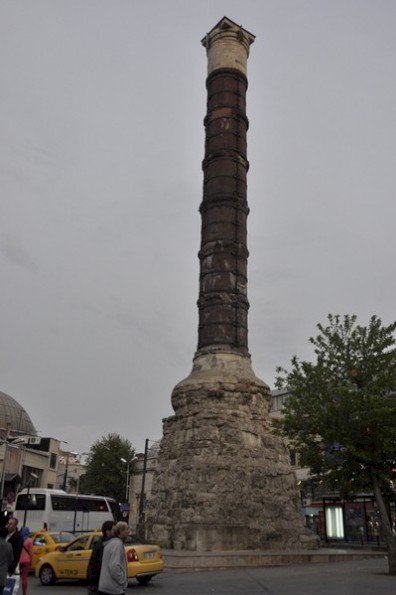Constantinople, Column of Constantine
Q1247287Column of Constantine: monument in Constantinople, commemorating the completion of the new city.
As is well known, Constantinople was founded by the emperor Constantine the Great (r.306-337). Actually, it was a refoundation; Byzantium already existed and was merely renamed on Sunday 8 November 324. Several Christian officials were present, but the job was done by the usual team of pagan priests, astrologers, and augurs. The city was not meant to be a capital, nor was it a Christian city.

Two years later, the emperor celebrated his Vicennalia, his twenty-year jubilee, in Rome. However, there were some riots during the festival and there was a political crisis. It must have been at this moment that the emperor decided to leave Rome behind, and on Monday 4 November 328 new rituals were performed in Constantinople, now to dedicate the city as capital. Among the attendants were the Neoplatonist philosopher Sopater and pontifex maximus Praetextus.
A year and a half later, on Monday 11 May 330, when the festival of Saint Mocius was celebrated, the city was finally dedicated. The goddess Tyche was invited to come and live in the city, and her statue was placed in the hand of the statue of the emperor that was on top of the Column of Constantine, on the oval Forum with the same name.
So, the Column, which is nowadays known as Çemberlitaş ("the hooped column") was erected to commemorate the moment on which Constantinople became the New Rome, the imperial residence par excellence.
Originally, it stood on a pedestal with five steps, but there's not much left of it. Iron hoops have been added to stabilize the shaft. This seems to have happened after one of the earthquakes of 416, 464, or 532. The statue, which represented Constantine as Sol Invictus, was struck by lightning in 1079note and was toppled by a storm in 1106.note The head of the statue was brought to the palace.note
Later, a cross was put on top of the column, but this was removed when the Ottoman Turks conquered Constantinople in 1453. A fire in 1779 damaged the monument even more. Nevertheless, it has recently been restored and is still standing.